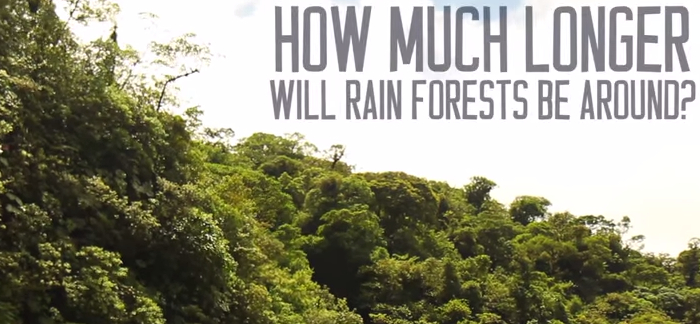Take a deep breath. The air that you’re breathing in that one breath was partially created by the tropical rainforests that call this planet home. About one-third of the oxygen that can be found at any given time came from this landscape. We all need trees to be able to breathe, but trees in their natural environment do more than just provide oxygen. It is a living habitat that encourages the growth of other plants, becomes a home for animals, and helps our world thrive.
Unfortunately the tropical rainforests are being chopped down at an alarming rate. With current deforestation techniques, a 120 yard section of rainforest is permanently removed every second so that farming or other land use needs can be accomplished. This limits animal habitats and eventually limits the quality of the air that each of us breathe.
That’s why knowing these fund facts about the tropical rainforest is so important. When the rainforest is see as a living, thriving environment that is filled with awesome opportunities that don’t require the trees to be removed, then we all win.
1. The Canopy is Super Thick
Because there is so much moisture in a tropical rainforest, the tree growth is phenomenal. The trees pack themselves in tightly because they don’t have to compete with one another to get water. The end result is a very thick canopy overhead that shades the ground from sunlight. The canopy is so thick that is can sometimes take 10 minutes for a single drop of water to hit the ground because it needs to make its way down through the leaves.
Some tropical rainforests have bamboo plants growing in them as well. This adds to the thickness of the canopy very quickly. Under the right conditions, a giant bamboo plant can grow up to 9 inches every day.
2. That’s a Lot of Life
The moist tropical rainforests are the home of many plants and animals. In the rainforests of Central Africa, for example, there are more than 8,000 different kinds of plants that grow. If you were to look in the South American rainforests, you’d find over 2,000 different types of butterflies calling the area home. In total, tropical rainforests only cover about 2% of the world’s total surface, but more than half of all life on Earth lives within this environment.
There are plenty of frogs, snakes, and squirrels that call the rainforest home too. One of those animals, a sloth, moves very slowly. So slowly, in fact, that when they live in the rainforests that are moist and damp in South America, they have algae that grows on their fur. If you took a 4 mile square section of any given tropical rainforest, you’d find over 700 different types of trees and about 1,500 different types flowers.
If you counted all of the species of life in the tropical rainforest, you’d get about 15 million in total. What is amazing is that scientists believe that they have studied just 1% of this amazing environment.
3. It’s More Than Just Rare Air
The tropical rainforests are important for a number of reasons to humans. It isn’t just the oxygen that helps us breathe that we need from the rainforests. About 25% of the active ingredients in our modern medicines come from rainforest plants. A number of the fruits we eat every year are pollinated by the bats that call the rain forest home.
If we were to keep destroying the rainforest, then we would be destroying our future along with it. About 80% of the flowers that are found in Australian rainforests are not found anywhere else in the world. Scientists find new animals and new plants every year while studying the rainforest. We have barely begun to understand that potential of this unique environment. Getting 2,000 trees for lumber per second helps the building industry right now, but short-term gains could cost the planet its long-term potential.
4. Water Is Nice to Have
Plants, animals, and humans all need to have fresh water in order to survive. Tropical rainforests help to provide that water thanks to the heavy levels of rainfall that they are able to generate. These rains also help to balance out the weather around the planet, so when the tropical rainforests are out of balance, so is the weather.
The Amazon basin is one of the most important places for water on the planet. About 20% of all the fresh water that exists on the Earth right now can be found right there. We need the Amazon basin and all tropical rainforests to support the drinking water that we all need.
5. It’s a Cancer Fighter
Although 5 year survival rates for cancer have increased quite a lot over the last decade, there isn’t a proven cure for this disease as of yet. There are a number of plants that can help to treat people with cancer, however, so they can fight off the symptoms of cancer and even have it removed from their body. 70% of the plants that are used in these treatments for cancer can only be found in the tropical rainforest.
6. Sun and Rain Aren’t a Pain
Because the tropical rainforests are right around the equator, they get a lot of sunlight every day. About 12 hours per day, to be exact, because the equatorial zone doesn’t have the seasonal modifications from the tilt of the Earth like the temperate zones do. In the tropical rainforest, the temperatures rarely fall below 70F. On the other hand, they also rarely exceed 93F.
The reason why the temperatures are so regulated is because of the regular rain. Some tropical rainforest areas can received over 260 inches of rain every year. That means the humidity levels are routinely above 75%. That means it’s the not the heat, but the humidity that’s going to sap your energy in this environment.
Part of the reason why there is so much humidity is because of the trees. Each tree goes through a process called transpiration. This occurs when moisture comes out of the tree through the pores of the leaves. This happens so often that some tropical rainforests receive up to half of their precipitation through the transpiration process.
7. It’s a Lot Like an Onion
One of the first memorable conversations between Shrek and Donkey is how Shrek describes ogres as onions. “They’ve got layers,” he tells Donkey. Ogres and onions might have layers, but so does the tropical rainforest. There’s actually four different layers that make up this environment. The first, called the emergent layer, is where the top of the canopy exists. The leaves get a lot of sunlight here and they protect the ground below.
The canopy is the next layer of the rainforest. This is where many of the other trees are located. The crowns of each tree are able to block much of the rest of the sunlight that breaks through the first top layer.
The understory is the third layer of this environment. Although almost no sunlight reaches down to the understory at any given time, there are still lots of plants, small trees, bushes, and other forms of plant life that grow because they don’t need as much sunlight to survive. This is the layer where much of the animal life tends to live.
The final layer, which is the ground, is where the larger animals and the burrowing animals live together. The ground provides the nutrients for the other three layers to survive and in doing so, it is able to thrive in its own unique way too.
8. Was That a Mirror?
One of the unique features of the tropical rainforest is that they all look the same, no matter what continent they happen to be on. Tropical rainforests have trees that grow very tall and straight because there is so much competition for sunlight. The bark on the trees is very thin and smooth because very little protection is needed with the regular temperatures. There are usually no branches for at least 100 feet because there is no sunlight available to support branch growth.
Another similarity is that all of the rainforests thrive in their differences of animal life. Although the types of insects and animals tends to be the same, there are different species found in every rainforest. What you’ll find in the American rainforests, for example, won’t be the same as what you’ll find in the Asian rainforests.
9. They Work Together
Although there are predators and prey in the rainforest, there isn’t an actual dominant species. The biodiversity of the environment allows for species support across all animals so there aren’t infestations or random deaths that eliminate a species. In the tropical rainforest, everyone works together. It’s a lesson from the rainforest we could all take to heart.
The tropical rainforest is a beautiful place that is filled with many mysteries still today. If we each do our own part to help protect this environment, then the Earth will thank us with every breath we each take.




